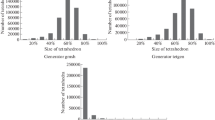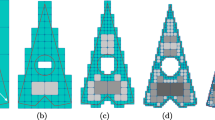Abstract
A fully automatic surface mesh generation system is presented in this paper. The automation is achieved by an automatic determination of a consistent mesh size distribution, which is based on geometry rasterisation. The user specifies a minimal and maximal allowed mesh size, and a maximal allowed curvature angle for the complete geometry, or, rather, parts of it. Now, these local curvature and local characteristic lengths of the geometry are computed, which determine the local mesh size. These local mesh sizes are stored and smoothed in a Cartesian background mesh. Afterwards, the triangulation is generated by an advancing front triangulator: the local resolution of the surface triangulation is determined by the mesh sizes stored in the Cartesian background mesh. The object-oriented design and implementation is described. The complete system is very fast due to an efficient parallelisation based on MPI for computer systems with distributed memory.




















Similar content being viewed by others
References
Hirschel EH, Schwarz W (1995) Mesh generation for aerospace CFD applications. In: Surveys on mathematics for industry, vol 4. Springer, Berlin Heidelberg New York, pp 249–265
Hitzel SM, Tremel U, Deister F, Rieger H (2003) Complex configuration meshing—an industrial view and approach. AIAA paper 2003-4130
TranscenData (2002) CADfix—version 5.0 training manual. http://www.transcendata.com
Weatherill NP (1999) Unstructured grids: procedures and applications. In: Thompson JF, Soni BK, Weatherill NP (eds) Handbook of grid generation, chap 26. CRC Press, Boca Raton, Florida
McMorris H, Kallinderis Y (1997) Octree-advancing front methods for generation of unstructured surface and volume meshes. AIAA J 35(6):976–984
Deister F, Hirschel EH (2002) Self-organizing hybrid Cartesian grid/solution system with multigrid. AIAA paper 2002-0112
Gamma E, Helm R, Johnson R, Vlissides J (1995) Design patterns: elements of reusable object-oriented software. Addison-Wesley, Reading, Massachusetts
Stroustrup B (1997) The C++ programming language, 3rd edn. Addison-Wesley, Reading, Massachusetts
FLITE-3D user manual (1996) Computational and Civil Engineering Department, University of Wales Swansea, Singleton Park, Swansea SA2 8PP
Tremel U, Deister F, Hassan O, Weatherill NP (2004) Automatic unstructured surface mesh generation for complex configurations. Int J Numer Meth Fl 45:341–364
Yerry MA, Shephard MS (1984) Automatic three-dimensional mesh generation by the modified-octree technique. Int J Numer Meth Eng 20:1965–1990
Bonet J, Peraire J (1991) An alternating digital tree (ADT) algorithm for 3D geometric searching and intersection problems. Int J Numer Meth Eng 31:1–17
Foley JD, van Dam A, Feiner SK, Hughes JF(1996) Computer graphics—principles and practice, 2nd edn. Addison-Wesley, Reading, Massachusetts
Piegl LA, Richard AM (1995) Tessellating trimmed NURBS surfaces. Comput Aided Des 27(1):16–26
Samet H (1989) Neighbour finding in images represented by octrees. Comput Vis Graph Image Processing 46(3):367–386
Tremel U, Deister F, Hassan O, Weatherill NP (2003) Parallel generation of unstructured surface grids. In: Proceedings of 12th international meshing roundtable, Santa Fe, New Mexico, October 2003. Sandia National Laboratories, SAND-2003-3030P, pp 43–53
Acknowledgements
The authors would like to thank Dr. Stephan M. Hitzel, EADS M, for the preparation of the CAD model for the generic fighter aircraft configuration.
Author information
Authors and Affiliations
Corresponding author
Rights and permissions
About this article
Cite this article
Deister, F., Tremel, U., Hassan, O. et al. Fully automatic and fast mesh size specification for unstructured mesh generation. Engineering with Computers 20, 237–248 (2004). https://doi.org/10.1007/s00366-004-0291-5
Received:
Accepted:
Published:
Issue Date:
DOI: https://doi.org/10.1007/s00366-004-0291-5




